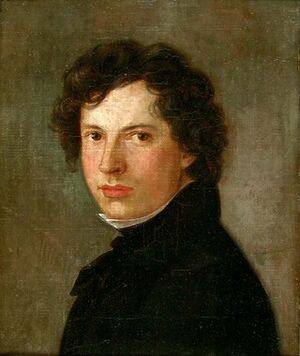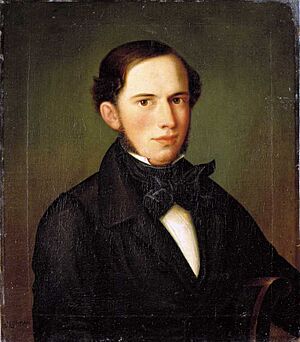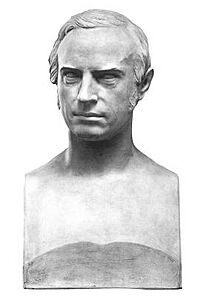Johan Sebastian Welhaven facts for kids
Johan Sebastian Cammermeyer Welhaven (born December 22, 1807 – died October 21, 1873) was an important Norwegian writer, poet, and critic. He also studied art. Many people think he was one of the most important people in Norwegian literature.
About Welhaven's Life
Johan Welhaven was born in Bergen, Norway in 1807. His family had many talented members. His grandfather was a teacher. His father, Johan Ernst Welhaven, was a pastor. His mother, Else Margaret Cammermeyer, was also from a family of pastors.
His sister, Maren Sars, was married to a famous biologist, Michael Sars. Their children became famous too. These included the historian Ernst Sars, the marine biologist Georg Ossian Sars, and the singer Eva Nansen. Johan Welhaven himself was the father of the Norwegian architect Hjalmar Welhaven.
Welhaven went to Bergen Cathedral School from 1817 to 1825. In 1828, he started studying theology (the study of religion). After his father died, he moved to the capital city to continue his studies. He finished his exams at the University of Christiania in 1827. After that, he focused on writing and literature.
He traveled to France and Germany in 1836. Later, in 1858, he went to Italy to study archaeology (the study of old things and cultures). In 1840, he became a lecturer in philosophy at the Royal Frederik's University in Christiania. He gave many talks about literature.
In 1843, he got a full-time job at the university. Some people disagreed with this because he had not finished his theology degree. Also, he had not published any books on philosophy. Another writer, Henrik Wergeland, also wanted the job. Wergeland had finished his theology degree. Welhaven became a professor in 1846.
He taught philosophy at the university for 26 years, from 1840 to 1866. He also became a director of the Society of Arts. This helped him have a bigger impact. He died in Christiania in 1873.
Welhaven's Work and Ideas
Welhaven became known as a writer who supported traditional ideas in Norwegian literature. He disagreed with the ideas of extreme nationalists. These were people who wanted Norwegian culture to be very different from other European countries. Welhaven wanted Norwegian culture to be more like that of other European nations. He followed the romantic style of writing. He was influenced by the Danish writer J.L. Heiberg.
He is famous for his disagreements with another important Norwegian writer, Henrik Wergeland. This disagreement was about their different ideas on Norwegian culture and poetry. Welhaven also had a romantic relationship with Wergeland's younger sister, Camilla Collett.
In 1834, Welhaven wrote a series of poems called Norges Dæmring ("The Dawn of Norway"). In these poems, he shared his ideas about art and writing. He published a book of Digte ("Poems") in 1839. Then, in 1845, he published Nyere Digte ("Newer Poems"). He wrote more poems in 1847, 1848, 1851, and 1859.
Welhaven was well known for writing about nature and old Norwegian stories (folklore). An example is his poem «Asgaardsreien» from Nyere Digte. This poem later inspired Peter Nicolai Arbo's famous painting The Wild Hunt of Odin. Welhaven also wrote poems about religion, like «En Sangers Bøn» (The Prayer of a Singer). In this poem, he showed his spiritual side. He wrote about caring for other people and his Christian faith.
In the 1840s, Welhaven was a key figure in the national romanticism movement in Norway. This movement celebrated Norwegian history, nature, and folklore. Welhaven also helped start the career of Hans Gude, a famous romantic painter. It was Welhaven who first suggested that Gude should study art at the Academy of Art in Düsseldorf.
Some of Welhaven's Books and Poems
- Til Henrik Wergeland! (1830)
- Henrik Wergelands Digtekunst og Polemik ved Aktstykker oplyste (1832)
- Norges Dæmring. Et polemisk Digt (1834)
- Digte (1839)
- Nyere Digte (1845)
- Halvhundrede Digte (1848)
- Reisebilleder og Digte (1851)
- En Sjel i Vildmarken (1856)
- En Digtsamling (1860)
- Ewald og de norske Digtere (1863)
- Samlede Skrifter (1867–68)




